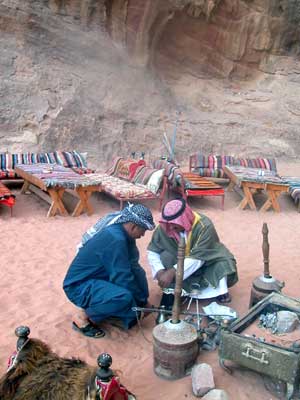|
|
||
|
. Adventures in desert . Adventure with nomads . Adventures in canyons . Adventures by camels . Adventures by horses . Adventures by jeeps . home page |
||
|
DrinksWater was a precious commodity. Throughout the interior it was only dependably found at some waterholes and at various springs associated with oases. There are no rivers in Arabia. On the rare occasions when a wadi was in spate due to heavy rain, the flow could be disastrous in its power and was likely to run for a day or two at most. With luck it would leave a few pools of water and would raise water levels in adjacent wells for a few months. There were only limited technical means of recovering ground water, the haddaj and suany or draw well driven by a camel or ox was the practical limit of mechanization. Some permanent waterholes were 60 feet deep and required considerable effort to draw water with bucket and rope. If a large camel herd or caravan had to be watered the Bedouin would work in relays for several hours, often with considerable fear of attack if there were ghrazzu (raiding parties) known to be in the vicinity. The quality of the water was often poor. At frequently used waterholes several travelers noted the contamination of the water with urea percolating into the water source from the camel urine concentrated around the waterhole. Doughty comments on many sub-standard supplies "brackish water ...thick well water full of old wafted camel droppings......tasting like alum.....mawkish water causing illness in my companions......salty bitter water.....water full of wriggling white vermin drunk through the lap of the kerchief.....muddy puddle water...". Yet he claimed that he had never been ill from consumption of any of these doubtful sources. Coffee, kahwa, was the prime social drink . The ring of coffee pestle on the mortar as the freshly roasted beans were crushed was the signal for men to gather at the coffee tent for the exchange of news and recounting of stories. Guests were received by the host who would frequently prepare the coffee himself. "We sat down to drink coffee with the sheykh, Misshel, who would make it himself. This ruler of seven tribes roasted, pounded, boiled and served the cheerful mixture with his own hand. Misshel poured me out but one cup, and to his tribesmen two or three. Because this shrew's deed was in disgrace of my being a Nasrany, I exclaimed, "here is a great sheikh and a little kahwa!" Thus challenged, Misshel poured me out unwillingly, muttering some word of his fanatical humour". Coffee was always freshly roasted in a mahmas (roasting spoon) stirred with a maqlab. The roast beans would be cooled in a mabradah, a wooden tray. They were brayed in a mihbash or nijir made of wood, iron or brass. In some bedouin families the coffee was brewed in a dedicated pot made of clay, medlah. It would be transferred to the classic beaked Arabian coffee pot of tinned copper or brass, dalla and served in small ceramic cups, finjeyn. It was often flavoured with cardamom. Milk, haleeb, from camel, goat and sheep was consumed, although preference was for camel's milk. Of the three the camel's milk was drunk whole and the other two usually after the butter had been made. Doughty reports a hierarchy of bedouin views on the relative merits of the three milk sources: "Camel milk is the best of all sustenance, and the very best is that of the bukkra, the young camel with her first calf, as lightly purgative. Ewe's milk is very sweet and fattest of all, it is unwholesome to drink whole, it kills people with colic ..... ewe buttermilk should be let sour some while in the semily (butterskin) with other milk, until all are tempered together, and then it is fit to drink. Goat milk is sweet, it fattens more than strengthens the body." These observations are borne out by modern analysis of the milk. An appended table compares the main characteristics with cow's milk from tropical breeds. Cattle were kept in the oases but are recorded as being of poor quality. The dromedary cow has a gestation period of 370 to 375 days and only breeds every second year commencing at four years of age and continuing until 20 or so years of age. Calving is very seasonal coinciding with the winter rains and the presence of good feed stocks. The lactation period varies according to the camel's nutrition but is usually 18 months with yields of 1,000 to 3,000 liters per year and individual milkings up to 5 litres being common. The milk is rich in vitamin C which is of particular benefit to the bedouin who have little access to fresh fruit and vegetables. The milk diet was however not satisfying in some respects; Bedouin complained to Doughty of the "creeping hunger" and begged him for "Damascus kaak (biscuit), it is six weeks since I have chewed anything". Tea drinking was introduced at a relatively late stage but has become well established. Doughty may be held responsible in part for its introduction as he carried supplies for his own consumption and several times offered it to bedouin who had not tasted it before. They were generally unimpressed with the tea flavour, considering it insubstantial compared to coffee, but did enjoy the sugar
|
||
|
|
Tel: +962777282730, +962777517069 Fax: 00962 3 2154 999 E-mail: info@jordanbeauty.com Web: www.jordanbeauty.com |
|

